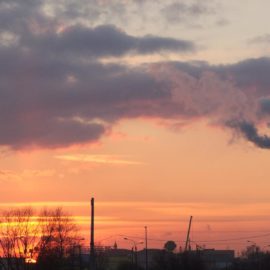
The Maosaic plant in St James discovered that they pollute less so they want loser standards.
A longstanding agricultural fertilizer production plant in western St. James Parish is asking state regulators to significantly cut its authority to send harmful particles and toxic ammonia into the air. Through a standard permit renewal, Mosaic Fertilizer has proposed cutting the company’s legal authority to send up fine particles into the air by nearly 12% and cut toxic emissions by 61% from its Faustina plant along the Mississippi River’s west bank, permit records show. Officials who operate the Mosaic-Faustina plant, which is about 3 miles southeast of Donaldsonville, say a combination of factors have led to the planned reductions, but the major reason stems from required tests that have shown its main emissions stacks aren’t sending up as much pollution as previously thought.
nola.com
This is how the state regulates pollution. On its face, it looks like the company is doing the right thing.
The proposed permit change highlights a major way the state and industry regulate air emissions in Louisiana, through standard equipment emissions rates, double-checked periodically, that help govern what regulators estimate a plant can and does release into the air. Ron Yasurek, general manager of Mosaic’s operations in Louisiana, attributed the reduced emissions rates from those stacks to better operational control, more consistent maintenance and equipment cleaning practices, and a change more than a decade ago in the source phosphate rock for its production lines, which is now mined in Peru. Yasurek told Louisiana Department of Environmental Quality officials that the plant’s actual reported air emissions have fallen well below the existing permit levels for the past five or more years. “Mosaic takes the safety of its employees, its neighbors and the environment seriously. These results are representative of that,” he said during a hearing on the air permit in the Welcome community late last week. “We do this because we try to be a good neighbor.”
There are two plants separated by the Mississippi.
Faustina has a sister operation in St. James Parish across the river known as Uncle Sam. They work together to make granular ammonium phosphate fertilizer. The two plants have about 340 employees combined and remain a leading employer in the parish. The fertilizer is used across the United States and the world for row crops, including corn, soybeans and cotton. If adopted by DEQ, the cuts in the air permit limits at the Faustina plant will mean a reduction in Mosaic’s authority to release pollution at that site by close to 50 tons per year in each of the two variety of fine particulates tracked by federal and state regulators and about 1,080 tons per year in ammonia, a toxic pollutant. Ammonia, a common pollutant from fertilizer plants, isn’t a known carcinogen and can be found throughout nature at low levels but can cause serve respiratory problems and even death in the highest concentrations, according to federal agencies.
Fine particulates don’t kill you but can aggravate illness.
Exposure to fine particulates have been linked to a variety of respiratory and cardiovascular problems, including high blood pressure, heart attacks and asthma. The proposed particulate emissions limits would be around 360 to 364 tons per year, depending on the size of particle, and total toxic emissions limits would be around 701 tons per year. The proposed permit would also allow small increases in some other toxic chemicals, including hydrofluoric acid and fluorides, and somewhat larger increases in pollutants known to cause haze and smog, including sulfur and nitrogen oxides, carbon monoxide and volatile organic compounds. In recent years, the rural area of northern St. James where Mosaic’s Faustina plant is located has been the focus of new plant proposals that have generated public opposition and seen those plants run into regulatory, legal or financial slowdowns. The high concentration of Black residents in the area has also raised environmental justice concerns that have drawn national scrutiny. The St. James Parish Council recently refused to grant a zoning change that would have allowed one of those plant proposals, South Louisiana Methanol, to pursue new industrial suitors for its site after the original project ran into financial problems and failed to get off the ground.
Overall the particulates dropped in the Parish.
Overall, however, combined toxic air emissions in the parish trended down between 2012 and 2020, falling about 44%, federal data show. During a lightly attended air permit hearing Thursday, Jasmine Moll, an environmental science and policy specialist with Healthy Gulf, an environment group, called for a full environmental justice review before the permit is adopted due to the high concentration of Black residents near the plant. Federal air emissions data, which are self-reported, show the Faustina plant’s toxic pollution has fallen well below even the proposed lower the permit levels for past eight years, but the proposed reductions also come as Mosaic is trying to resolve five different DEQ enforcement actions involving its Faustina and Uncle Sam plants. They include alleged air emissions violations at Mosaic’s Faustina operation. The U.S. Environmental Protection Agency also found the Faustina plant has had significant air quality violations each quarter for the last three years and has had seven informal or formal EPA actions against it over the past five years, though they have resulted in only a $300 fine.
DEQ does not change permits as long as there are still open violation cases.
DEQ typically doesn’t issue new permits until agency violations are resolved. In a hearing before a state administrative law judge on Wednesday, a DEQ attorney said the state and Mosaic are working on global settlement of the state cases but Mosaic first has to correct violations previously noted at its Faustina plant. “So, we can’t reach a settlement on that particular site until they are in compliance,” agency attorney Claudia Rush said. In Louisiana, air permit limits are based on the combined releases of all manner of equipment from rented generators and pumps to large chemical storage tanks and towering stacks and flares. Those emissions, in most cases, aren’t measured continuously in the way utilities measure home water and electricity use to determine the monthly bill. The emissions are estimated calculations based on productions levels and standard equipment emissions rates generated by EPA and equipment manufacturers.
DEQ requires a “stack test”
Under DEQ’s air program, the agency requires industrial plants to periodically check those predictions through what’s known as a “stack test.” Plants run different units through scenarios to see how they perform and what the emissions’ rates actually are. According to DEQ records, Mosaic’s stack tests, going back to 2018, show the main production trains at the Faustina plant are emitting at rates far lower than previously predicted. Yasurek said, through the new permit, the company is committing itself to those lower emissions levels based on those stack tests. “Again, it’s based on the results that we’re getting, so actual test results are how we’re basing these,” he said. DEQ is accepting public comments on the air permit through end of business Monday.
I am sure Mosaic knew the states position so this is just showing intent. Is this being a good neighbor? Let’s ask Sharon!



